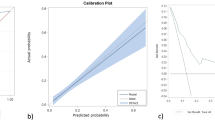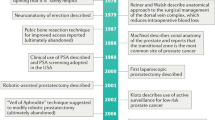Abstract
It has been shown that an adequate lymphadenectomy for exact staging of prostate cancer consists of removal of all the tissue along the external iliac vein, in the obturator fossa and along the internal iliac artery. Morbidity associated with this procedure is low, if certain technical details are respected. This review discusses in detail the indications for lymphadenectomy and the extent of dissection, based on the localization of the positive nodes. The potential therapeutic impact of extended lymph node dissection in men with prostate cancer is also addressed.
This is a preview of subscription content, access via your institution
Access options
Subscribe to this journal
Receive 12 print issues and online access
$209.00 per year
only $17.42 per issue
Buy this article
- Purchase on Springer Link
- Instant access to full article PDF
Prices may be subject to local taxes which are calculated during checkout


Similar content being viewed by others
References
Partin AW et al. (2001) Contemporary update of prostate cancer staging nomograms (Partin Tables) for the new millennium. Urology 58: 843–848
Mathiesen O et al. (1990) Axillary sampling and the risk of erroneous staging of breast cancer. An analysis of 960 consecutive patients. Acta Oncol 29: 721–725
Siewert JR et al. (1998) Relevant prognostic factors in gastric cancer: ten-year results of the German Gastric Cancer Study. Ann Surg 228: 449–461
Friedberg V (1989) Results of 108 exenteration operations in advanced gynecologic cancers. Geburtshilfe Frauenheilkunde 49: 423–427
Caplin S et al. (1998) For patients with Duke's B (TNM Stage II) colorectal carcinoma, examination of six or fewer lymph nodes is related to poor prognosis. Cancer 83: 666–672
Mills RD et al. (2001) Pelvic lymph node metastases from bladder cancer: outcome in 83 patients after radical cystectomy and pelvic lymphadenectomy. J Urol 166: 19–23
Leissner J et al. (2000) Lymphadenectomy in patients with transitional cell carcinoma of the urinary bladder; significance for staging and prognosis. BJU Int 85: 817–823
Wolf JS Jr et al. (1995) The use and accuracy of cross-sectional imaging and fine needle aspiration cytology for detection of pelvic lymph node metastases before radical prostatectomy. J Urol 153: 993–999
Paik ML et al. (2000) Limitations of computerized tomography in staging invasive bladder cancer before radical cystectomy. J Urol 163: 1693–1696
Tempany CM and McNeil BJ (2001) Advances in biomedical imaging. JAMA 285: 562–567
Wawroschek F et al. (2003) Prostate lymphoscintigraphy and radio-guided surgery for sentinel lymph node identification in prostate cancer. Technique and results of the first 350 cases. Urol Int 70: 303–310
Jeschke S et al. (2005) Detection of early lymph node metastases in prostate cancer by laparoscopic radioisotope guided sentinel lymph node dissection. J Urol 173: 1943–1946
Mattei A et al. (2005) Advantages of preoperative imaging with Technetium-99m-nanocolloid for prostate-sentinel-lymph-node-adenectomy: accuracy and surgical detection time using presurgical imaging guidance prior to gamma-probe-detection versus gamma-probe detection alone. J Urol 173: 433
Gronau E et al. (2005) Sentinel lymph node resection in prostate cancer patients with a PSA higher than 20ng/ml. J Urol 173: 437
Harisinghani MG et al. (2003) Noninvasive detection of clinically occult lymph-node metastases in prostate cancer. N Engl J Med 348: 2491–2499
Stone NN et al. (1997) Laparoscopic pelvic lymph node dissection for prostate cancer: comparison of the extended and modified techniques. J Urol 158: 1891–1894
Heidenreich A et al. (2002) Extended pelvic lymphadenectomy in patients undergoing radical prostatectomy: high incidence of lymph node metastasis. J Urol 167: 1681–1686
Weingärtner K et al. (1996) Anatomical basis for pelvic lymphadenectomy in prostate cancer: results of an autopsy study and implications for the clinic. J Urol 156: 1969–1971
Bader P et al. (2002) Is a limited lymph node dissection an adequate staging procedure for prostate cancer? J Urol 168: 514–518; discussion 518
Bluestein DL et al. (1994) Eliminating the need for bilateral pelvic lymphadenectomy in select patients with prostate cancer. J Urol 151: 1315–1320
Petros JA and Catalona WJ (1992) Lower incidence of unsuspected lymph node metastases in 521 consecutive patients with clinically localized prostate cancer. J Urol 147: 1574–1575
Bishoff JT et al. (1995) Pelvic lymphadenectomy can be omitted in selected patients with carcinoma of the prostate: development of a system of patient selection. Urology 45: 270–274
Heidenreich A et al. (2004) Extended pelvic lymphadenectomy in men undergoing radical retropubic prostatectomy (RRP)—an update on > 300 cases. J Urol 171: a312
Tenaglia JL and Iannucci M (online March 2004) Extended pelvic lymphadenetomy for the treatment of localized prostate carcinoma. European Urology Today 15: 15 [http://www.uroweb.nl/files/uploaded_files/EUT%202004%20MAR.pdf] (accessed 10 June 2005)
Clark T et al. (2003) Randomized prospective evaluation of extended versus limited lymph node dissection in patients with clinically localized prostate cancer. J Urol 169: 145–147; discussion 147–148
Link RE and Morton RA (2001) Indications for pelvic lymphadenectomy in prostate cancer. Urol Clin North Am 28: 491–498
Schumacher M et al. (2004) Lymph node metastasis in patients with prostate cancer and with a PSA < 10ng/ml? Eur Urol 2 (Suppl 3): s17
Burkhard FC et al. (2005) Is pelvic lymphadenectomy really necessary in patients with a serum prostate-specific antigen level of <10 ng/ml undergoing radical prostatectomy for prostate cancer? BJU Int 95: 275–278
Jhaveri FM et al. (1999) Biochemical failure does not predict overall survival after radical prostatectomy for localized prostate cancer: 10-year results. Urology 54: 884–890
Han M et al. (2001) Long-term biochemical disease-free and cancer-specific survival following anatomic radical retropubic prostatectomy. The 15-year Johns Hopkins experience. Urol Clin North Am 28: 555–565
Bader P et al. (2003) Disease progression and survival of patients with positive lymph nodes after radical prostatectomy. Is there a chance of cure? J Urol 169: 849–854
Roehl KA et al. (2004) Cancer progression and survival rates following anatomical radical retropubic prostatectomy in 3,478 consecutive patients: long-term results. J Urol 172: 910–914
Steinberg GD et al. (1990) Management of stage D1 adenocarcinoma of the prostate: the Johns Hopkins experience 1974 to 1987. J Urol 144: 1425–1432
Frazier HA et al. (1994) Does radical prostatectomy in the presence of positive pelvic lymph nodes enhance survival? World J Urol 12: 308–312
deKernion JB et al. (1990) Prognosis of patients with stage D1 prostate carcinoma following radical prostatectomy with and without early endocrine therapy. J Urol 144: 700–703
Zwergel U et al. (2004) Lymph node positive prostate cancer: long-term survival data after radical prostatectomy. J Urol 171: 1128–1131
Catalona WJ et al. (1988) Intermediate-term survival results in clinically understaged prostate cancer patients following radical prostatectomy. J Urol 140: 540–543
Pound CR et al. (1999) Natural history of progression after PSA elevation following radical prostatectomy. JAMA 281: 1591–1597
Golimbu M et al. (1987) Radical prostatectomy for stage D1 prostate cancer. Urology 30: 427–435
Aus G et al. (2003) Prognostic factors and survival in node-positive (N1) prostate cancer—a prospective study based on data from a Swedish population-based cohort. Eur Urol 43: 628
Cheng L et al. (2001) Risk of prostate carcinoma death in patients with lymph node metastasis. Cancer 91: 66–73
Bader P et al. (2004) Limited lymph node dissection in prostate cancer may miss lymph node metastasis and determines outcome of apparently pN0 prostate cancer. Eur Urol 3: 16
Daneshmand S et al. (2004) Prognosis of patients with lymph node positive prostate cancer following radical prostatectomy: long-term results. J Urol 172: 2252–2255
Allaf ME et al. (2004) Anatomical extent of lymph node dissection: impact on men with clinically localized prostate cancer. J Urol 172: 1840–1844
Dimarco DS et al. (2005) The extent of lymphadenectomy for pTXN0 prostate cancer does not affect prostate cancer outcome in the prostate specific antigen era. J Urol 173: 1121–1125
Di Blasio CJ et al. (2003) Association between number of lymph nodes removed and freedom from disease progression in patients receiving pelvic lymph node dissection during radical prostatectomy for prostate cancer. J Urol 169: a456
Palapattu GS et al. (2004) Prostate specific antigen progression in men with lymph node metastases following radical prostatectomy: results of long-term followup. J Urol 172: 1860–1864
Cadeddu JA et al. (1997) Stage D1 (T1-3, N1-3, M0) prostate cancer: a case-controlled comparison of conservative treatment versus radical prostatectomy. Urology 50: 251–255
Messing E et al. (2003) Immediate hormonal therapy compared with observation after radical prostatectomy and pelvic lymphadenectomy in men with node-positive prostate cancer; Results at 10 years of EST 3886. J Urol 169: 396
Author information
Authors and Affiliations
Corresponding author
Ethics declarations
Competing interests
The authors declare no competing financial interests.
Glossary
- GLEASON SCORE
-
Sum of grades assigned to the two largest cancerous areas of tissue samples; grades range from 1 (least aggressive) to 5 (most aggressive)
- SENTINEL NODE LYMPHOSCINTIGRAPHY
-
This procedure involves injecting radiosiotopes into the prostate gland in order to detect the primary lymphatic landing sites
- COLLIMATOR
-
A device that restricts light or radiation to a parallel beam to enable specialized internal measurements
- WATCHFUL WAITING
-
Also known as observation, this involves closely monitoring a patient's condition but withholding treatment until symptoms appear or change
Rights and permissions
About this article
Cite this article
Burkhard, F., Schumacher, M. & Studer, U. The role of lymphadenectomy in prostate cancer. Nat Rev Urol 2, 336–342 (2005). https://doi.org/10.1038/ncpuro0245
Received:
Accepted:
Issue Date:
DOI: https://doi.org/10.1038/ncpuro0245
This article is cited by
-
PSMA PET/CT and PET/MRI in primary staging of prostate cancer and its effect on patient management
Clinical and Translational Imaging (2023)
-
Sentinel lymph node: established and new areas of use
Clinical and Translational Imaging (2015)
-
Laparoscopic sentinel lymph node (SLN) versus extensive pelvic dissection for clinically localized prostate carcinoma
European Journal of Nuclear Medicine and Molecular Imaging (2012)
-
Reduction in incidence of lymphocele following extraperitoneal radical prostatectomy and pelvic lymph node dissection by bilateral peritoneal fenestration
World Journal of Urology (2008)
-
A review of high-risk prostate cancer and the role of neo-adjuvant and adjuvant therapies
World Journal of Urology (2008)



